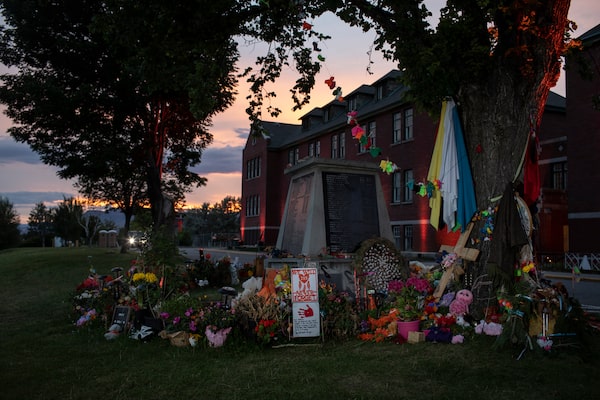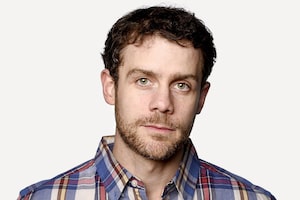
Flags and lights are seen as a vigil takes place where ground-penetrating radar recorded hits of what are believed to be 751 unmarked graves near the grounds of the former Marieval Indian Residential School on the Cowessess First Nation, Sask.Mark Taylor/The Canadian Press
Ottawa is fielding more than 100 requests for financial assistance from Indigenous communities intent on launching searches for unmarked graves, a volume of demand certain to deplete government funding commitments and stretch the availability of archeological expertise in the country, according to Indigenous leaders and academics.
The federal government said earlier this month it would distribute $27-million for First Nations to locate, identify and commemorate Indigenous children buried in undocumented sites of former residential schools.
By last week, the number of initial inquiries for that financial support had climbed past 100, according to Indigenous Services Canada spokeswoman Leslie Michelson. The surge in interest followed announcements by Tk’emlúps te Secwépemc Nation in British Columbia and Cowessess First Nation in Saskatchewan of the discovery of hundreds of unmarked graves on the grounds of former residential schools.
With many project proposals in the early stages, the total cost and complexity of the work countrywide is difficult to measure. The potential search sites lie beneath landfills and parking lots, farmers’ fields and golf courses. They vary in size from patches of grass to the equivalent of multiple football fields. Clues to their whereabouts remain buried in historical surveys and fading memories.
With Alberta’s commitment last week of $8-million toward finding unmarked graves, government funds for the task now total around $50-million. The final tab could be 20 times that, according to Indigenous leaders and academics experienced in such searches.
“When you look at the work that’s needed, it’s a drop in the bucket,” Chief Mike Sack of Sipekne’katik First Nation in Nova Scotia said of the money committed so far.
Federation of Sovereign Indigenous Nations to receive funding for research of burial sites
Ontario to commit $10-million to identify and commemorate residential school burial sites
Past searches using ground penetrating radar have scraped by on federal grants as low as $20,000. The sum would cover radar work over a small, well-defined area conducted by academics labouring for free. In Brantford, Ont., meanwhile, Six Nations of the Grand River Chief Mark Hill is asking for $10-million from Ottawa, a figure meant to represent the full tab of a broad archeological search, followed by a forensic examination and all the psychological and spiritual supports needed to help the community grapple with the emotional fallout.
If that $10-million estimate is applied to each of the more than 130 former residential school sites identified by the Truth and Reconciliation Commission, the total national bill quickly reaches north of $1-billion.
“There needs to be consideration around the spiritual supports, the psychological supports,” said Kisha Supernant, director of the Institute of Prairie and Indigenous Archaeology at the University of Alberta. “Then there are questions about commemoration, about whether forensic analysis needs to take place. I suspect we’ll see more project estimates closer to what Six Nations is asking.”
So far, provincial governments in Alberta, Saskatchewan, Manitoba and Ontario have pledged a total of $22.5-million to cover the work. Ottawa’s $27-million is what remains of a $33.8-million commitment made in the 2019 budget.
The federal money has begun to flow, with $4.88-million being set aside last week for the Federation of Sovereign Indigenous Nations, which represents 74 First Nations in Saskatchewan, including Cowessess.
“These funds will help with research, knowledge gathering and the initial ceremonies related to the burial sites of children who never returned from residential schools to their Indigenous communities,” said Kyle Fournier, spokesman for the office of Crown-Indigenous Relations Minister Carolyn Bennett.
Roughly 17 of the more than 130 sites identified by the Truth and Reconciliation Commission have standing school buildings, making for relatively straightforward search grids. The remaining 113 or so get complicated.
“We might have survivors telling us about a place east of the school, but if we don’t know where the school was – that’s going to take us some time,” University of Saskatchewan archeologist Terence Clark said. “You can’t just have survivors point to an empty field and then put down a flag and say ‘Okay, we’ll search here.’”
To get their bearings, researchers will need to dig through historical surveys, talk to land owners about the history of the area, and spend time pinpointing old septic fields, waterpipes and other subterranean infrastructure.
“If you don’t do that, you’re just wasting effort going out into the field with the [ground-penetrating radar],” said Dr. Clark.“If every school is going to be six football fields worth of work, that’s millions of dollars for every single school. And so that’s not practical.”

A makeshift memorial for the 215 children whose remains were found at the Kamloops Indian Residential School in Kamloops, B.C.Amber Bracken/The New York Times News Service
That kind of complexity may well be the situation on the grounds of the former Shubenacadie Indian Residential School, about 50 kilometres north of Halifax. The school building was demolished in 1986. A plastics factory and farmland now occupy the land. Sipekne’katik First Nation is working with Saint Mary’s University archeologist Jonathan Fowler to scour the grounds, but the scope can change frequently.
“On a daily basis, we’re getting people coming in saying you have to check this spot or that spot,” Mr. Sack said.
A former school in Kenora, Ont., been replaced by a parking lot. In Cranbrook, B.C., there’s now a hotel resort and golf course where a school once stood.
Six Nations of the Grand River First Nation also faces a broad and evolving search focus associated with the Mohawk Institute Residential School, which occupied four different buildings during its 142 years of operation. Mr. Hill says one of his community’s possible burial areas lies beneath a municipal landfill. Others have been identified on farms, around water mains and in a park.
Six Nations has set up a working group of residential school survivors to advise on potential burial areas.
“We’ve got some very big plots of land to be searched,” Mr. Hill said. “The goal is to search every area identified in every last story.”
In previous years, much of search work has been conducted for free by a group of about 20 Canadian academics with experience in archeological geophysics. With so much demand on their expertise in the wake of the Tk’emlúps te Secwépemc announcement about the Kamloops Indian Residential School, they’ll be in short supply.
“For this to be done by academics, there’s just not enough of us to go around,” Dr. Supernant said. “The private sector will need to be engaged. That does of course increase the cost.”
The Canadian Archaeological Association is developing guidelines for communities. For example, the association’s website advises ground-penetrating radar can never identify burials with 100-per-cent certaintyand that forested areas likely need to be cleared of undergrowth to get a solid signal.
Some in the group are concerned rushed work could lead to poor results.
“I worry about the pace,” Dr. Supernant said. “There seems to be a rush to to do this work when it actually takes time and care.”
On Vancouver Island, residential school survivor Steve Sxwithul’txw felt that urgency when he and two others started an online fundraiser on June 1 to buy radar equipment to scour the island’s former residential school grounds. The goal was $25,000; the total now stands at $144,420.
He’s heard from experts stressing the need for care and deliberation, but he’s just as aware of the pressing need to heal traumatized communities.
“We wanted to do something as three Indigenous people to help move this forward as quickly as possible: the work of getting our children found and buried in a place where they belong.”
With a report from Kristy Kirkup in Ottawa
Our Morning Update and Evening Update newsletters are written by Globe editors, giving you a concise summary of the day’s most important headlines. Sign up today.
 Patrick White
Patrick White